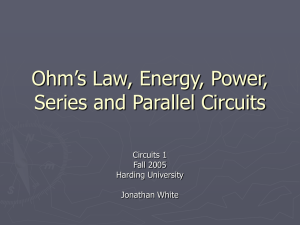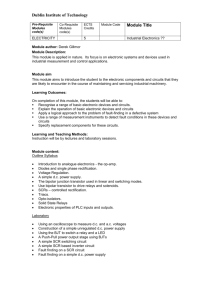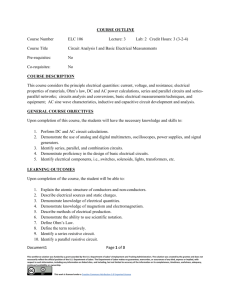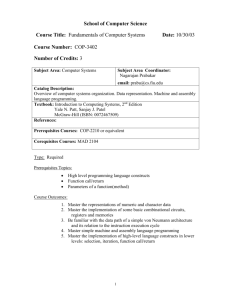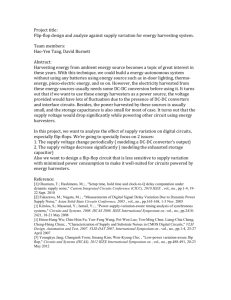elec.101 - Citrus College
advertisement
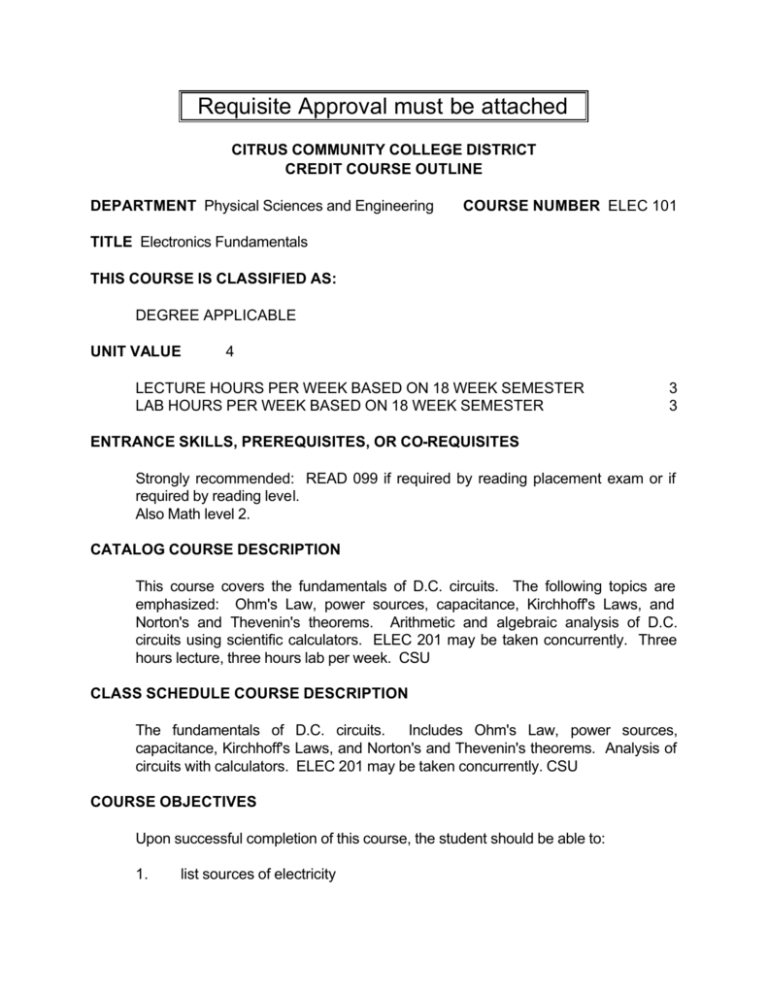
Requisite Approval must be attached CITRUS COMMUNITY COLLEGE DISTRICT CREDIT COURSE OUTLINE DEPARTMENT Physical Sciences and Engineering COURSE NUMBER ELEC 101 TITLE Electronics Fundamentals THIS COURSE IS CLASSIFIED AS: DEGREE APPLICABLE UNIT VALUE 4 LECTURE HOURS PER WEEK BASED ON 18 WEEK SEMESTER LAB HOURS PER WEEK BASED ON 18 WEEK SEMESTER 3 3 ENTRANCE SKILLS, PREREQUISITES, OR CO-REQUISITES Strongly recommended: READ 099 if required by reading placement exam or if required by reading level. Also Math level 2. CATALOG COURSE DESCRIPTION This course covers the fundamentals of D.C. circuits. The following topics are emphasized: Ohm's Law, power sources, capacitance, Kirchhoff's Laws, and Norton's and Thevenin's theorems. Arithmetic and algebraic analysis of D.C. circuits using scientific calculators. ELEC 201 may be taken concurrently. Three hours lecture, three hours lab per week. CSU CLASS SCHEDULE COURSE DESCRIPTION The fundamentals of D.C. circuits. Includes Ohm's Law, power sources, capacitance, Kirchhoff's Laws, and Norton's and Thevenin's theorems. Analysis of circuits with calculators. ELEC 201 may be taken concurrently. CSU COURSE OBJECTIVES Upon successful completion of this course, the student should be able to: 1. list sources of electricity CITRUS COMMUNITY COLLEGE DISTRICT ELEC 101 Electronics Fundamentals CREDIT COURSE OUTLINE Page 2 2. 3. compute voltage, current, and resistance calculate power dissipation in loads 4. compute using network theorems 5. list values of color-coded resistors 6. measure voltage, current, and resistance using a V.O.M. 7. connect circuits from schematics 8. convert complicated circuits to simple circuits 9. list dangers of electric shock 10. compute reactance of inductors and capacitors 11. compute parallel and series capacitances and inductance 12. measure voltage using a oscilloscope REQUIRED TEXTS AND MATERIALS Principles of Electric Circuits, Floyd The reading for this course is: PRIMARILY COLLEGE LEVEL REQUIRED ASSIGNMENTS OUTSIDE OF CLASS Over an 18 week presentation of the course three hours per week are required for each unit of credit. Two hours of independent work done out of class are required for each hour of lecture. Students will be required to complete the following types of assignments outside of the regular class time: Study Answer questions Read required materials Solve problems DEGREE APPLICABLE COURSE: CITRUS COMMUNITY COLLEGE DISTRICT ELEC 101 Electronics Fundamentals CREDIT COURSE OUTLINE Page 3 2 hours of independent work done out of class per each hour of lecture or class work, or 3 hours lab, practicum, or the equivalent, per unit. COURSE CONTENT I. Units and Notations A. Systems of units B. Powers of ten C. Conversion from one system to another D. Laws of units II. Current and Voltage A. Atoms and their structure B. The ampere C. Voltage, batteries D. Conductors and insulators III. Resistance A. Introduction, temperature effects B. Wire tables C. Types of resistors D. Color coding, conductance IV. Capacitors A. Introduction, the electric filed B. Capacitance, dielectric strength C. Types of capacitors, transients in capacitive networks D. Energy stored by a capacitor, stray capacitances V. Magnetic Circuits A. Introduction, magnetic fields B. Domain theory of magnetism C. Ohm’s law for magnetic circuits D. Magnetizing force, hysteresis, Ampreres circuital law. VI. Inductors A. Introduction, Faraday’s law of electromagnetic induction B. Types of inductors C. Induced voltage D. Energy stored in an inductor VII. Ohm’s Law, Power, and Energy CITRUS COMMUNITY COLLEGE DISTRICT ELEC 101 Electronics Fundamentals VIII. CREDIT COURSE OUTLINE Page 4 A. Ohm’s Law B. Power C. Efficiency D. Energy Series and Parallel Circuits A. Introduction, mechanical analogies B. Series circuits, Kirchhoff’s voltage law C. Voltage divider rule, parallel circuits D. Kirchhoff’s current law, current divider rule IX. Series-Parallel Networks A. Analysis of series-parallel networks B. Descriptive examples X. Network Analysis A. Introduction, current sources B. Mesh analysis (loop current method) C. Superposition theorem, Thevenin’s theorem D. Maximum power transfer theorem XI. Instruments A. The D’Arsonval movement, the ammeter B. Voltmeter C. The ohmmeter, multimeters D. Oscilloscope XII. Alternating Current A. Introduction, definition, and symbols B. The sine wave C. Peak, average, and effective values XIII. Transformers A. Introduction, mutual inductance B. The iron-core transformer C. The transformer as an isolation device D. Nameplate data, types of transformers Laboratory I. A series of laboratory experiments from Fiske and Harter designed to reinforce the theory gained in the lecture portion of the course and to show practical application of the theory. CITRUS COMMUNITY COLLEGE DISTRICT ELEC 101 Electronics Fundamentals II. CREDIT COURSE OUTLINE Page 5 Locally prepared laboratory experiments and problems designed to evaluate the students' progress. METHODS OF INSTRUCTION Lecture/Laboratory METHODS OF ASSESSMENT ESSAY OR SUBSTANTIAL WRITING ASSIGNMENT Includes not only "blue book" examinations but any written assignment of sufficient length and complexity to require students to select and organize ideas as well as to explain them. COMPUTATIONAL OR NON-COMPUTATIONAL PROBLEM-SOLVING Critical thinking should be demonstrated by the solution of unfamiliar problems that admits various solutions or various strategies for achieving the solution. SKILL DEMONSTRATION A course grade may not be based solely on attendance. Revised & Classified: October, 1988 Revised: March, 1993 Revised: July, 1995 Revised: March, 1996 Revised: January, 1997 Revised: December, 1997 Revised: March, 2001 CITRUS COMMUNITY COLLEGE DISTRICT REQUISITE APPROVAL The Requisite Approval form must be completed for any course that carries a prerequisite, corequisite, or limitation on enrollment as indicated on the Course Approval form. Department: Physical Sciences and Engineering Course number: ELEC 101 I. Title: Electronics Fundamentals RECOMMENDED REQUISITE(S): Strongly recommended: READ 099 if required by reading placement exam or if required by reading level. Also Math level 2. II. TYPE OF REQUISITE AND THE APPROPRIATE LEVEL OF SCRUTINY. CIRCLE THE APPROPRIATE LETTER: H. ADVISORY. Advisories require content review, but do not require a finding that they are necessary for student success. They only require the recommendation of faculty in the department or discipline and of the Curriculum Committee that they significantly enhance student success in the course. III. CONTENT REVIEW. FACULTY SHOULD BASE CONTENT REVIEW ON THE SYLLABUS AND OUTLINE OF RECORD, TESTS, RELATED INSTRUCTIONAL MATERIALS, TESTS, AND GRADING CRITERIA. CHECK THE APPROPRIATE BOX TO INDICATE THAT THE CONTENT REVIEW HAS BEEN COMPLETED: þ For courses to be used as requisites or advisories, compare the knowledge and/or skills needed at entry with those taught in the requisite, concurrent, or advisory course. A. LIST THE SPECIFIC SKILLS, CONCEPTS REQUIRED FOR SUCCESS IN THE COURSE: B. AND INFORMATION 1. Ability to read college level material. 2. Ability to solve arithmetic problems and simple equations. LIST THE SPECIFIC SKILLS, CONCEPTS AND INFORMATION THE STUDENT WILL ATTAIN IN THE REQUISITE COURSE OR THAT WILL BE CITRUS COMMUNITY COLLEGE DISTRICT ELEC 101 Electronics Fundamentals REQUISITE APPROVAL Page 2 MEASURED WITH THE REQUISITE TEST: NOTE: 1. Ability to read college level material. 2. Ability to solve arithmetic problems and simple equations. Per District policy and procedures the completed and approved Requisite Approval form is considered to be part of the official course outline of record.


